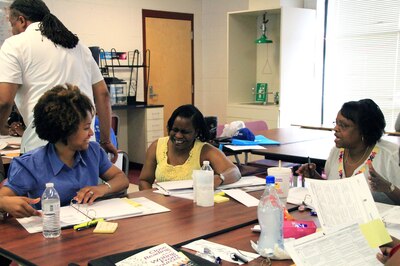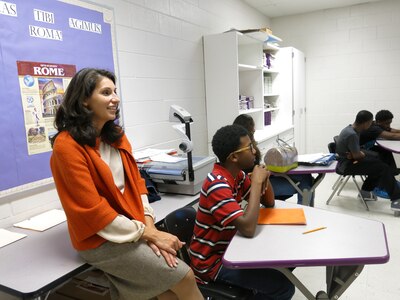As Shelby County students settle into classes this fall, they’re likely to notice some big changes: dedicating more minutes to daily reading, breaking off into smaller groups, and lesson plans that span multiple days.
The changes come as part of the district’s new war on the abysmal literacy rates in Memphis schools, reflecting a battle that’s being waged across Tennessee. Standardized test scores were released this week, and the percentage of students proficient in elementary and middle school reading dropped statewide by 1.1 percentage points. So did the percentage of students proficient in Shelby County.
In Memphis, fifth-grade teacher Donald Dyer is among district troops who are mobilizing colleagues at summer training sessions and talking up the necessity of improving reading skills across the curriculum. After all, when only 30 percent of an urban school district’s third-graders and half of its 8th-graders read on grade level, it takes a village.
“We’ve got to empower teachers in all different subject areas to teach literacy, because the problem is so large,” said Dyer, a teacher at Kate Bond Elementary School, while leading a recent training event. “We’ve got to get everyone well informed on what’s changing.”

Approximately 3,500 of more than 7,000 teachers in Shelby County Schools will have participated in the district’s literacy training by next month when the new school year resumes. And they’re not just teachers of English, language arts or reading. They’re teachers of math, science and social studies. They’re elementary school teachers with multiple subjects.
“We want rigorous texts and solid reading and writing strategies in all classrooms and inside of all content areas,” explained chief academic officer Heidi Ramirez about the district’s shift in strategy.
Ramirez, who came to Tennessee’s largest public school system last fall, has spearheaded the district’s comprehensive literacy improvement plan. She implemented a similar plan at Milwaukee Public Schools, where she served as chief academic officer from 2010 to 2012.
Because student reading skills are foundational to learning, graduation and career readiness, literacy training is high on the district’s summer professional development options for teachers, reflecting Ramirez’ philosophy that all teachers should be literacy teachers.
But Shelby County Schools has its work cut out for it. Superintendent Dorsey Hopson’s Destination 2025 vision plan aims to boost third-grade reading proficiency from 30 percent to 90 percent by 2025. That will require annual boosts of 5 percent, or 470 students.
And as this year’s test data showed, Shelby County students are back-tracking. To combat the slide, the district is using tools that range from across-the-curriculum interventions to literacy-based partnerships with churches and nonprofit organizations.
In February, Ramirez unveiled her plan of action before the Shelby County Board of Education, where she contended that though the district’s reading and language arts proficiency rate is increasing, it’s not fast enough. From 2013 to 2014, the rate for grades 3-8 increased by 1.6 percent. At that pace, it will be 2050 before the district reaches its 90 percent goal.
“It’s an ambitious project with many different groups that all need to be on the same page,” said Ramirez, who briefed principals on the instructional changes last spring. “That’s why this summer training is so important.”
New teaching strategies in classrooms will include:
- Increased daily reading times in pre-kindergarten through fifth grade — specifically 50 minutes of reading in pre-K, and 90 minutes of reading and 30 minutes of writing in K-5 classrooms;
- Use of “whole group” and “small group” instruction, in which the teacher teaches the whole classroom a skill and then directs students to practice that skill in smaller groups;
- Lessons spanning multiple days at the high school level, a change from lessons traditionally spanning a single day.
For math and science teachers, it will be challenging to incorporate literacy into instruction, since they haven’t had to in the past, according to educators. That’s why the district-level trainings are critical, said Josalyn Tresvant-McGhee, a teacher at Knight Road Elementary School.
“This time is so important because it’s a planning session; we get practical ideas from it,” Tresvant-McGhee said. “Teachers learn best from each other.”
Still, some teachers say the literacy plan guidelines have been muddy at best.
“The vision is good, but practically, how is this going to be implemented and implemented at all levels in schools?” asked Nikki Wilks, an English teacher at Kingsbury High School. “There’s no overnight fix to this, and while this is a step in the right direction, I’m worried that teachers won’t make the necessary changes because practical application and reinforcement lack.”

Wilks said the district’s new curriculum maps, which diagram a curriculum to identify and record data that identifies core skills and content, emphasize the importance of incorporating the literacy plan into instruction and aligning instruction with the state’s new standardized exam, known as TNReady. However, the map doesn’t specifically say how.
“The curriculum map’s extremely vague, which is interesting considering everyone keeps telling us we have to follow them to a T,” said Wilks, who attended multiple training sessions throughout the summer.
Others warn that to truly stall the literacy slide, it’s going to take a village of more than just teachers. A child’s earliest years have a huge influence on their lifelong academics, and parents have to know that literacy starts as soon as they are born, said J. Helen Perkins, an associate professor at the University of Memphis who specializes in literacy.
“We have to emphasize the crucial importance of encouraging and teaching parents to speak to their children at home, to read with them, to teach them their ABCs,” Perkins said. “Too often, we see children come to us well into elementary school without even knowing how to write their own name. Teachers alone are not responsible for that.”
Perkins said she believes the district will make gains in literacy when teachers are well-trained and well-supported.
“Trained and expert literacy coaches would really help in this district as they support the classroom teachers,” Perkins said. “Administrators must be aware of what the best practices are and assist teachers in implementing those best practices in their classrooms with fidelity.”
Support will come in 35 literacy coaches, a first for the district, who have been hired for the fall. Their full-time role will be to support quality reading and literacy, Ramirez said.
She added, however, that it will take time, and some growing pains, to implement all of her plan. She said increased teacher participation in summer trainings is a good sign.
Dyer, who has helped lead some of those trainings, says the professional development sessions are a good first step.
“We can’t hold teachers accountable for what we haven’t told them to do,” he said.

